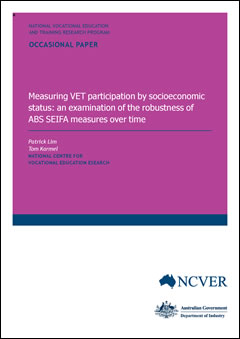Description
At every five-yearly census, the Australian Bureau of Statistics recalculates both the SEIFA (Socio-economic Indexes for Areas) indexes and also recalibrates the borders and sizes of the geographic areas from which these SEIFA measurements are derived. The NCVER reports vocational education and training (VET) participation rates at least annually, and the question that arises is how well the SEIFA indexes perform over the interim years. The authors find that there is little distortion in the measurement of participation in the intervening periods.
Summary
About the research
At every five-yearly census, the Australian Bureau of Statistics (ABS) recalculates both the SEIFA (Socio-economic Indexes for Areas) indexes and also recalibrates the borders and sizes of the geographic areas from which these SEIFA measurements are derived. Further, over time, the composition of geographic areas may change, due to urban renewal or other factors.
The National Centre for Vocational Education Research (NCVER) reports vocational education and training (VET) participation rates at least annually, and the question that arises is how well do the SEIFA indexes perform over the interim years, that is, between the releases of new census data. Of particular interest is the reporting of participation rates for the census years. In reporting the 2011 year, NCVER uses the 2006 census data, as the ABS does not release new SEIFA values until 18 months after each census. The focus of this paper is on VET participation rates; however, the methodology would be equally applicable to higher education or school participation.
The approach used in this paper is that the 2006 and 2011 National VET Provider Collections have had the 2006 and 2011 SEIFA measures applied to each of them, along with the Australian populations at each time. Using these data, it was possible to determine VET participation rates (by age) as a proportion of the Australian population, using both the 2006 and 2011 census data. The SEIFA index used in this paper was the Index of Relative Socio-economic Disadvantage (IRSD).
Key messages
- The estimates of VET participation made for 2011 based on 2006 quintiles are reasonably accurate when the quintiles are based on statistical local areas (SLAs).
- The results based on postal areas (POAs) are not as accurate.
- The new Statistical Area 2 geographic boundaries will be more stable and accurate over time.
- The SEIFA quintiles (deciles) using area-based calculations are not to be taken as a robust benchmark in the sense of 20% of the population. That is, 20% of the population does not fall into the lowest quintile (for example). SEIFA quintiles are derived by ensuring that 20% of all geographic regions are in the quintile and thus the underlying distribution of the population does not evenly fall across the five quintiles.
- Any over- or under-representation of any socioeconomic status (SES) group cannot be judged accurately by whether the share of a particular quintile is over or under 20%.
Rod Camm
Managing Director, NCVER
